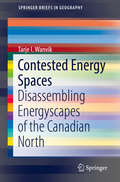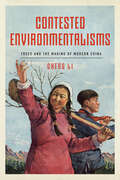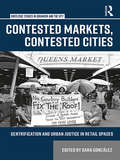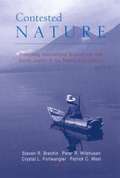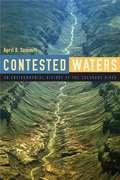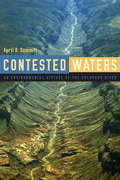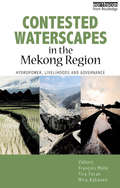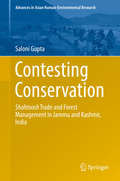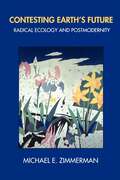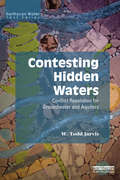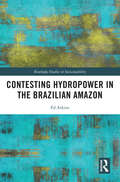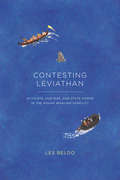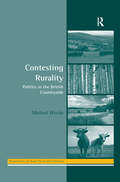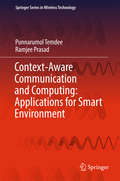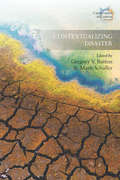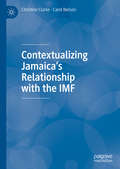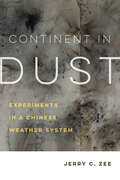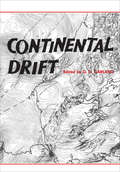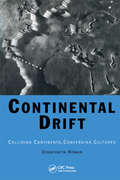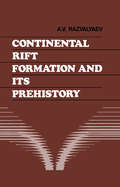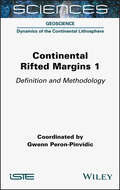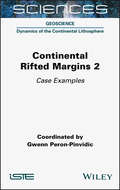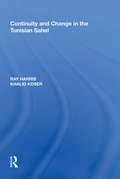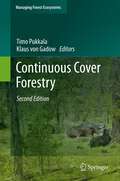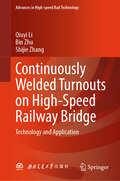- Table View
- List View
Contested Energy Spaces: Disassembling Energyscapes of the Canadian North (SpringerBriefs in Geography)
by Tarje I. WanvikThis authored brief discusses how to conceptualize the socio-material complexity of contested energy spaces in the Canadian North, specifically in the context of indigenous communities that have allowed industrial developments to occur on their lands despite the environmental and lifestyle consequences. By applying assemblage theory, the author identifies contested energy spaces as complex places or situations that need to be understood through geographical concepts of place, scale, and power. In 6 chapters, the book challenges preconceptions of indigenous peoples as victims by examining communities that favor industrial developments, and identifies instabilities in the Canadian North to analyze the power relations between industry, state and indigenous communities. The book will be of interest to undergraduate and graduate students, teachers and lecturers, and geography scholars.Chapter 1 introduces the concept of energy spaces, and addresses the main research question posed in the text; why do some indigenous communities support extractive industry developments on their traditional territories, despite substantial destruction of the local environment and traditional indigenous land use practices? Chapter 2 further elaborates on the conceptualization of contested energy spaces, and chapter 3 applies this to the study area in Alberta, Canada. Chapter 4 discusses the methodology of the research process, and chapter 5 presents empirical cases in Alberta, from the changing governance structures of energy spaces to the networking of local indigenous communities. Chapter 6 concludes the brief by summarizing he findings, and by offering advice to all stakeholders regarding the dangers of leaving government processes to market forces alone.
Contested Environmentalisms: Trees and the Making of Modern China
by Cheng LiFor decades, tree planting and forestry have been pivotal to Chinese environmentalism. During the Mao era, while forests were razed to fuel rapid increases in industrial production, the "Greening the Motherland" campaign promoted conservationist tree-planting nationwide. Contested Environmentalisms explores the seemingly contradictory rhetoric and desires of Chinese conservation from the early twentieth century through to the present. Drawing on literary, cinematic, scientific, archival, and digital media sources, Cheng Li investigates the emergence, evolution, and devolution of Chinese conservationist ideas. Combining literary, historical, and environmental studies approaches, he shows that these ideas acquired their value and assumed their power precisely because of their malleability and adaptability. Li historicizes authoritarian environmentalism and probes the global-local dynamics underlying conservationist ideas that energize environmental impulses in China. Examining ethnic borderlands, the Beijing political center, and China's growth on the world stage, this book demonstrates the strength of Chinese environmentalism to adapt and survive through tumultuous change lies in what seems to be a weakness: its inconsistency and contestation.
Contested Markets, Contested Cities: Gentrification and Urban Justice in Retail Spaces (Routledge Studies in Urbanism and the City)
by Sara GonzálezMarkets are at the origin of urban life as places for social, cultural and economic encounter evolving over centuries. Today, they have a particular value as mostly independent, non-corporate and often informal work spaces serving millions of the most vulnerable communities across the world. At the same time, markets have become fashionable destinations for ‘foodies’ and middle class consumers and tourists looking for authenticity and heritage. The confluence of these potentially contradictory actors and their interests turns markets into "contested spaces". Contested Markets, Contested Cities provides an analytical and multidisciplinary framework within which specific markets from Mexico City, Buenos Aires, Santiago de Chile, Quito, Sofia, Madrid, London and Leeds (UK) are explored. This pioneering and highly original work examines public markets from a perspective of contestation looking at their role in processes of gentrification but also in political mobilisation and urban justice.
Contested Nature: Promoting International Biodiversity and Social Justice in the Twenty-First Century
by Patrick C. West Crystal L. Fortwangler Peter R. Wilshusen Steven R. BrechinThis book contends that effective biological conservation and social justice must go hand in hand.
Contested Waters
by April R. Summit"To fully understand this river and its past, one must examine many separate pieces of history scattered throughout two nations--seven states within the United States and two within Mexico--and sort through a large amount of scientific data. One needs to be part hydrologist, geologist, economist, sociologist, anthropologist, and historian to fully understand the entire story. Despite this river's narrow size and meager flow, its tale is very large indeed." --From the conclusion The Colorado River is a vital resource to urban and agricultural communities across the Southwest, providing water to 30 million people. Contested Waters tells the river's story-a story of conquest, control, division, and depletion. Beginning in prehistory and continuing into the present day, Contested Waters focuses on three important and often overlooked aspects of the river's use: the role of western water law in its over-allocation, the complexity of power relationships surrounding the river, and the concept of sustainable use and how it has been either ignored or applied in recent times. It is organized in two parts, the first addresses the chronological history of the river and long-term issues, while the second examines in more detail four specific topics: metropolitan perceptions, American Indian water rights, US-Mexico relations over the river, and water marketing issues. Creating a complete picture of the evolution of this crucial yet over-utilized resource, this comprehensive summary will fascinate anyone interested in the Colorado River or the environmental history of the Southwest.
Contested Waters: An Environmental History of the Colorado River
by April R. Summitt"To fully understand this river and its past, one must examine many separate pieces of history scattered throughout two nations--seven states within the United States and two within Mexico--and sort through a large amount of scientific data. One needs to be part hydrologist, geologist, economist, sociologist, anthropologist, and historian to fully understand the entire story. Despite this river's narrow size and meager flow, its tale is very large indeed." -From the conclusion The Colorado River is a vital resource to urban and agricultural communities across the Southwest, providing water to 30 million people. Contested Waters tells the river's story-a story of conquest, control, division, and depletion. Beginning in prehistory and continuing into the present day, Contested Waters focuses on three important and often overlooked aspects of the river's use: the role of western water law in its over-allocation, the complexity of power relationships surrounding the river, and the concept of sustainable use and how it has been either ignored or applied in recent times. It is organized in two parts, the first addresses the chronological history of the river and long-term issues, while the second examines in more detail four specific topics: metropolitan perceptions, American Indian water rights, US-Mexico relations over the river, and water marketing issues. Creating a complete picture of the evolution of this crucial yet over-utilized resource, this comprehensive summary will fascinate anyone interested in the Colorado River or the environmental history of the Southwest.
Contested Waterscapes in the Mekong Region: Hydropower, Livelihoods and Governance
by François Molle Tira Foran Mira KäkönenThe catchment area of the Mekong River and its tributaries extends from China, through Burma/Myanmar, Thailand, Laos, Cambodia and to Vietnam. The water resources of the Mekong region - from the Irrawaddy and Nu-Salween in the west, across the Chao Phraya to the Lancang-Mekong and Red River in the east- are increasingly contested. Governments, companies, and banks are driving new investments in roads, dams, diversions, irrigation schemes, navigation facilities, power plants and other emblems of conventional 'development'. Their plans and interventions should provide some benefits, but also pose multiple burdens and risks to millions of people dependent on wetlands, floodplains and aquatic resources, in particular, the wild capture fisheries of rivers and lakes. This book examines how large-scale projects are being proposed, justified, and built. How are such projects contested and how do specific governance regimes influence decision making? The book also highlights the emergence of new actors, rights and trade-off debates, and the social and environmental consequences of 'water resources development'. This book shows how diverse, and often antagonistic, ideologies and interests are contesting for legitimacy. It argues that the distribution of decision-making, political, and discursive power influences how the waterscapes of the region will ultimately look and how benefits, costs and risks will be distributed. These issues are crucial for the transformation of waterscapes and the prospects for democratizing water governance in the Mekong region. The book is part of the action-research of the M-POWER (Mekong Program on Water, Environment and Resilience) knowledge network. Published with IFAD, CG|AR Challenge Program on Water & Food, M-POWER, Project ECHEL-EAU and HEINRICH BOLL STIFTUNG
Contesting Conservation
by Saloni GuptaThis book explores today’s changing intellectual climate, wherein understanding politics at different levels from global to local is considered mandatory in order to appraise the outcome of nature conservation interventions. By carefully examining two such processes – the ban on shahtoosh trade and the ‘National Afforestation Programme’ in the Indian state of Jammu and Kashmir, the book reveals how these processes are influenced by politics at different levels – from their introduction at the macro-level to their implementation at the micro-level – and in turn become coloured by the agendas and interests of the various stakeholders involved. Throughout the book, one priority is to give a voice to the poor resource-users who have been traditionally dependent on wildlife and forest resources for mere subsistence. Yet, these same people are who bear the brunt of nature conservation costs, rather than those actors who are responsible for the most serious violations in pursuit of greater profits. Contemporary Environmental Sociology is chiefly characterised by its focus on power relations in resource conservation and management. In ‘political ecology’ literature, too – especially after recognising the paradoxes and limitations of approaches such as ‘sustainable development’, ‘sustainable livelihoods’ and ‘community based natural resource management’ – there is a growing concern for critical analyses of multi-level politics in connection with nature conservation. The purpose of the book is not to challenge the gravity of environmental concerns, but to question the dominance of conservation interests over the subsistence needs of local communities, and to strike a balance between environmental and social justice. It argues that, unless and until more just accountability for the affected populations is ensured, conservation policies are unlikely to meet the goals of sustainable resource management. Given its critical engagement with human-nature conflicts in Jammu and Kashmir, the book offers a unique resource for students and scholars of Environmental Sociology, Political Ecology, Natural Resources Management, Conflict Studies and Human Rights Studies.
Contesting Earth's Future: Radical Ecology and Postmodernity
by Michael E. ZimmermanRadical ecology typically brings to mind media images of ecological activists standing before loggers' saws, staging anti-nuclear marches, and confronting polluters on the high seas. Yet for more than twenty years, the activities of organizations such as the Greens and Earth First! have been influenced by a diverse, less-publicized group of radical ecological philosophers. It is their work—the philosophical underpinnings of the radical ecological movement—that is the subject of Contesting Earth's Future.The book offers a much-needed, balanced appraisal of radical ecology's principles, goals, and limitations. Michael Zimmerman critically examines the movement's three major branches—deep ecology, social ecology, and ecofeminism. He also situates radical ecology within the complex cultural and political terrain of the late twentieth century, showing its relation to Martin Heidegger's anti-technological thought, 1960s counterculturalism, and contemporary theories of poststructuralism and postmodernity.An early and influential ecological thinker, Zimmerman is uniquely qualified to provide a broad overview of radical environmentalism and delineate its various schools of thought. He clearly describes their defining arguments and internecine disputes, among them the charge that deep ecology is an anti-modern, proto-fascist ideology. Reflecting both the movement's promise and its dangers, this book is essential reading for all those concerned with the worldwide ecological crisis.
Contesting Hidden Waters: Conflict Resolution for Groundwater and Aquifers (Earthscan Water Text)
by W. Todd JarvisThe world increasingly relies on groundwater resources for drinking water and the provision of food for a growing population. The utilization of aquifer systems also extends beyond freshwater supply to include other resources such as heat extraction and the storage and disposal of substances. Unlike other books about conflict resolution and negotiations over water resources, this volume is unique in focusing exclusively on conflicts over groundwater and aquifers. The author explores the specific challenges presented by these "hidden" resources, which are shown to be very different from those posed by surface water resources. Whereas surface watersheds are static, groundwater boundaries are value-laden and constantly changing during development. The book describes the various issues surrounding the governance and management of these resources and the various parties involved in conflicts and negotiations over them. Through first-hand accounts from a pracademic skilled in both process and substance as a groundwater professional and professional mediator, the book offers options for addressing the challenges and issues through a transdisciplinary approach.
Contesting Hydropower in the Brazilian Amazon (Routledge Studies in Sustainability)
by Ed AtkinsIn Contesting Hydropower in the Brazilian Amazon, Ed Atkins focuses on how local, national, and international civil society groups have resisted the Belo Monte and São Luiz do Tapajós hydroelectric projects in Brazil. In doing so, Atkins explores how contemporary opposition to hydropower projects demonstrate a form of ‘contested sustainability’ that highlights the need for sustainable energy transitions to take more into account than merely greenhouse gas emissions. The assertion that society must look to successfully transition away from fossil fuels and towards sustainable energy sources often appears assured in contemporary environmental governance. However, what is less certain is who decides which forms of energy are deemed ‘sustainable.’ Contesting Hydropower in the Brazilian Amazon explores one process in which the sustainability of a ‘green’ energy source is contested. It focuses on how civil society actors have both challenged and reconfigured dominant pro-dam assertions that present the hydropower schemes studied as renewable energy projects that contribute to sustainable development agendas. The volume also examines in detail how anti-dam actors act to render visible the political interests behind a project, whilst at the same time linking the resistance movement to wider questions of contemporary environmental politics. This interdisciplinary work will be of great interest to students and scholars of sustainable development, sustainable energy transitions, environmental justice, environmental governance, and development studies.
Contesting Leviathan: Activists, Hunters, and State Power in the Makah Whaling Conflict
by Les BeldoIn 1999, off the coast of the Pacific Northwest, the first gray whale in seven decades was killed by Makah whalers. The hunt marked the return of a centuries-old tradition and, predictably, set off a fierce political and environmental debate. Whalers from the Makah Indian Tribe and antiwhaling activists have clashed for over twenty years, with no end to this conflict in sight. In Contesting Leviathan, anthropologist Les Beldo describes the complex judicial and political climate for whale conservation in the United States, and the limits of the current framework in which whales are treated as “large fish” managed by the National Marine Fisheries Service. Emphasizing the moral dimension of the conflict between the Makah, the US government, and antiwhaling activists, Beldo brings to light the lived ethics of human-animal interaction, as well as how different groups claim to speak for the whale—the only silent party in this conflict. A timely and sensitive study of a complicated issue, this book calls into question anthropological expectations regarding who benefits from the exercise of state power in environmental conflicts, especially where indigenous groups are involved. Vividly told and rigorously argued, Contesting Leviathan will appeal to anthropologists, scholars of indigenous culture, animal activists, and any reader interested in the place of animals in contemporary life.
Contesting Rurality: Politics in the British Countryside (Perspectives on Rural Policy and Planning)
by Michael WoodsRural issues have gained national prominence in Britain in recent years. The future of hunting, the Foot and Mouth outbreak, farm income and agricultural reform and housing development have all claimed political and media attention, promoted by a vocal rural lobby and headline-grabbing protests and demonstrations. Combining detailed empirical research and case studies with theoretically informed critical analysis, this book provides an overview of the contemporary politics of the British countryside. It explores how and why rural issues have suddenly achieved such political prominence, by examining the changing politics and governance of rural Britain from the local to the national scale over the past century. It investigates the social, economic and institutional restructuring of rural communities and argues that we are witnessing not so much a rural politics, but a 'politics of the rural' in which the definition and representation of rurality itself has become the key focus of conflict.
Context-Aware Communication and Computing: Applications for Smart Environment (Springer Series in Wireless Technology)
by Ramjee Prasad Punnarumol TemdeeThis book introduces context-aware computing, providing definitions, categories, characteristics, and context awareness itself and discussing its applications with a particular focus on smart learning environments. It also examines the elements of a context-aware system, including acquisition, modelling, reasoning, and distribution of context. It also reviews applications of context-aware computing - both past and present - to offer readers the knowledge needed to critically analyse how context awareness can be put to use. It is particularly to those new to the subject area who are interested in learning how to develop context-aware computing-oriented applications, as well as postgraduates and researchers in computer engineering, communications engineering related areas of information technology (IT). Further it provides practical know-how for professionals working in IT support and technology, consultants and business decision-makers and those working in the medical, human, and social sciences.
Contextualizing Disaster (Catastrophes in Context #1)
by Mark Schuller Gregory V. ButtonContextualizing Disaster offers a comparative analysis of six recent "highly visible" disasters and several slow-burning, "hidden," crises that include typhoons, tsunamis, earthquakes, chemical spills, and the unfolding consequences of rising seas and climate change. The book argues that, while disasters are increasingly represented by the media as unique, exceptional, newsworthy events, it is a mistake to think of disasters as isolated or discrete occurrences. Rather, building on insights developed by political ecologists, this book makes a compelling argument for understanding disasters as transnational and global phenomena.
Contextualizing Jamaica’s Relationship with the IMF
by Carol Nelson Christine ClarkeThis ambitious book provides a comprehensive quantitative and qualitative assessment of Jamaica’s ties to the International Monetary Fund, focusing on Jamaica’s historical relationship with the IMF and reflecting on the domestic and international discourse surrounding the evolution of this relationship. Notably, this volume presents a critical analysis of Jamaica’s first engagement with and departure from the IMF and interrogates the political economy of the period. Jamaica’s economic experiences are assessed in the context of major global events, including the food price crises of 2007 and the global economic crises of 2008 and 2009. This book also looks at policy implications, and its well-researched analysis will be of great value to practitioners and policymakers as well as academics.
Continent in Dust: Experiments in a Chinese Weather System (Critical Environments: Nature, Science, and Politics #10)
by Jerry C. ZeeIn China, the weather has changed. Decades of reform have been shadowed by a changing meteorological normal: seasonal dust storms and spectacular episodes of air pollution have reworked physical and political relations between land and air in China and downwind. Continent in Dust offers an anthropology of strange weather, focusing on intersections among statecraft, landscape, atmosphere, and society. Traveling from state engineering programs that attempt to choreograph the movement of mobile dunes in the interior, to newly reconfigured bodies and airspaces in Beijing, and beyond, this book explores contemporary China as a weather system in the making: what would it mean to understand "the rise of China" literally, as the country itself rises into the air?
Continental Drift
by G. D. GarlandThe possibility that the continents of the earth have undergone major changes in position during the earth's history has fascinated scholars for at least three hundred years. Recently, evidence from several scientific disciplines has shown that the possibility must be very seriously considered in any study of the surface features of the earth. The first part of this volume consists of papers given at a symposium on continental drift, held at the annual meeting of the Royal Society of Canada in Charlottetown in June 1964. They present the views of three geophysicists, a botanist, and an astronomer. In these papers, the present evidence for or against continental drift is reviewed and the authors in most cases draw their own conclusions. The reader will find that there is not unanimous agreement in favour of drift. Nearly all discussions of continental drift stress the possible separation of the Americas from Europe and Africa. Considerable work has been done on the tracing of structures, on each side of the Atlantic Ocean, which might once have been connected. Geologists and geophysicists working in the Arctic or on the eastern seaboard of Canada have an important contribution to make to this subject. The second part of this volume, therefore, consists of a group of papers, also presented at the Charlottetown meeting, which throw light on the complicated crustal structure of these regions. In any attempt to reconstruct North America as part of Europe the features described in these papers will have to be taken into account. Once again, the reader will find differences of opinion on the question of whether the evidence favours a separation of our continent from Europe. Indeed, it is because the theory of continental drift us so difficult to confirm without ambiguity by direct observation that it remains controversial but exciting.
Continental Drift: Colliding Continents, Converging Cultures
by Constantin RomanContinental Drift: Colliding Continents, Converging Cultures is as much an account of the impressions Western culture made on Constantin Roman as a young researcher from behind the Iron Curtain as a personal history of the developing new science of plate tectonics. The book elucidates the author's struggles against a web of bureaucracy to secure hi
Continental Rift Formation and its Prehistory
by A.V. RazvalyaevTranslation of the Russian edition of 1988 on peculiarities of the Arabian-Nubian Shield in the Precambrian, prerift magmatism in the Red Sea Rift zone, evolution of the crust in rift forming zones.
Continental Rifted Margins 1: Definition and Methodology
by Gwenn Peron-PinvidicRifted margins mark the transition between continents and oceans, which are the two first-order types of land masses on Earth. Rifted margins contribute to our understanding of lithospheric extensional processes and are studied by various disciplines of Earth Science (geology, geophysics, geochemistry). Thanks to better and wider public access to high-quality data, our understanding in these areas has improved significantly over these last two decades.This book summarizes this knowledge evolution and details where we stand today, with a series of case examples included. It is structured in a practical way, with concise text descriptions and comprehensive diagrams. Continental Rifted Margins 1 is a useful resource for students and newcomers to the rifted margin community - a "cookbook" of sorts to facilitate the reading of scientific publications and provide basic definitions and explanations.
Continental Rifted Margins 2: Case Examples
by Gwenn Peron-PinvidicRifted margins mark the transition between continents and oceans, which are the two first-order types of land masses on Earth. Rifted margins contribute to our understanding of lithospheric extensional processes and are studied by various disciplines of Earth Science (geology, geophysics, geochemistry).Thanks to better and wider public access to high-quality data, our understanding in these areas has improved significantly over these last two decades. This book summarizes this knowledge evolution and details where we stand today, with a series of case examples included. It is structured in a practical way, with concise text descriptions and comprehensive diagrams. Continental Rifted Margins 2 is a useful resource for students and newcomers to the rifted margin community – a "cookbook” of sorts to facilitate the reading of scientific publications and provide basic definitions and explanations.
Continuity and Change in the Tunisian Sahel (King's Soas Studies In Development Geography Ser.)
by Ray HarrisThe Tunisian Sahel is an extraordinary region for study. A unique and marginal zone in terms of its climate; its relationship to Europe and in its geo-political position as an Arab country in Africa, it provides a fascinating lens through which to study the complex geographical issues of continuity and change. Continuity and Change in the Tunisian Sahel explores just such issues using a number of sub-themes: Islam, the relationships the region has with the global economy, rural development, security, and urban form and function. Based on a well-established fieldwork course, and copiously illustrated with maps, diagrams, photographs, posters, quotations and tables, the book also includes practical advice on how to carry out fieldwork and field investigations in arid and semi-arid regions.
Continuous Cover Forestry: Assessment, Analysis, Scenarios (Managing Forest Ecosystems #23)
by Klaus Von Gadow Timo PukkalaAlthough the majority of the world's forest ecosystems are dominated by uneven-sized multi-species stands, forest management practice and theory has focused on the development of plantation monocultures to maximize the supply of timber at low cost. Societal expectations are changing, however, and uneven-aged multi-species ecosystems, selectively managed as Continuous Cover Forestry (CCF), are often believed to be superior to monocultures in addressing a wide range of expectations. This book presents methods which are relevant to CCF management and planning: analysing forest structures, silvicultural and planning, economic evaluation, based on examples in Europe, Asia, Africa and North and South America.
Continuously Welded Turnouts on High-Speed Railway Bridge: Technology and Application (Advances in High-speed Rail Technology)
by Bin Zhu Qiuyi Li Shijie ZhangThis book systematically and comprehensively expounds the calculation theory, design method and engineering application of CWR turnout on bridges on high-speed railway. This book applies the concept of systems engineering and considers the vehicle-turnout-bridge as a coupled system. It combines static analysis, dynamic simulation, laboratory tests, and field tests, integrating theoretical research with practical engineering applications. The book solves critical technical puzzles such as constitutive relationships in force transfer mechanisms and interactions between turnouts and bridges, optimal configurations of turnouts relative to bridges, and appropriate structural designs and parameters for turnout beams. It establishes the calculation theory and design method for welded turnouts on bridges, creating a complete technical framework that includes theoretical analysis, structural design, testing, monitoring, and technical standards, thereby ensuring the safe and stable operation of high-speed railway turnouts on bridges in China. Moreover, the book introduces innovative design concepts for controlling relative displacements between turnouts and bridges, proposes design methods for welded turnouts on high-speed railway bridges, conducts service status monitoring and dynamic performance testing, and validates a wealth of field data. It summarizes research findings and practical experiences in the field of welded turnout technology on high-speed railway bridges, serving as a valuable resource for industry professionals, college students, and postgraduates involved in high-speed railway track engineering.
